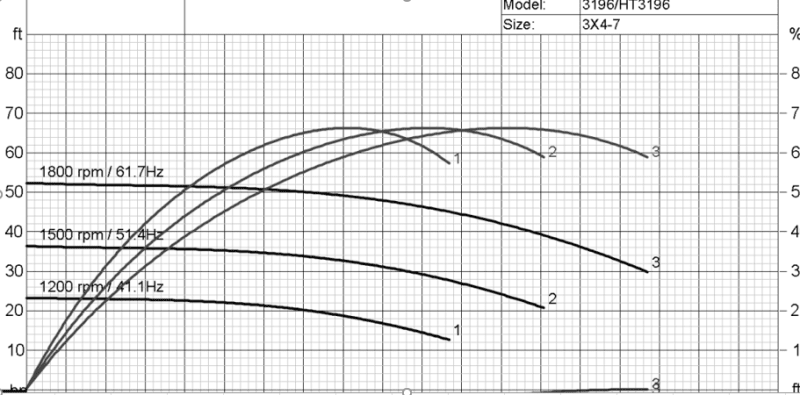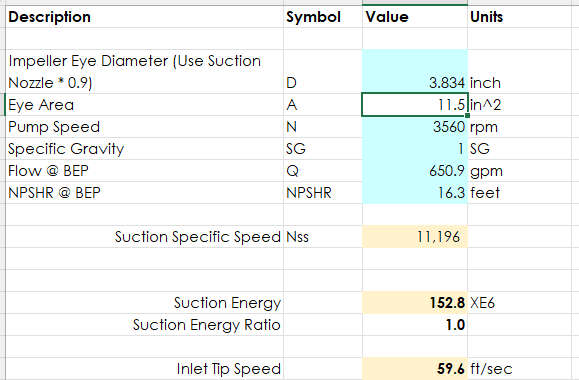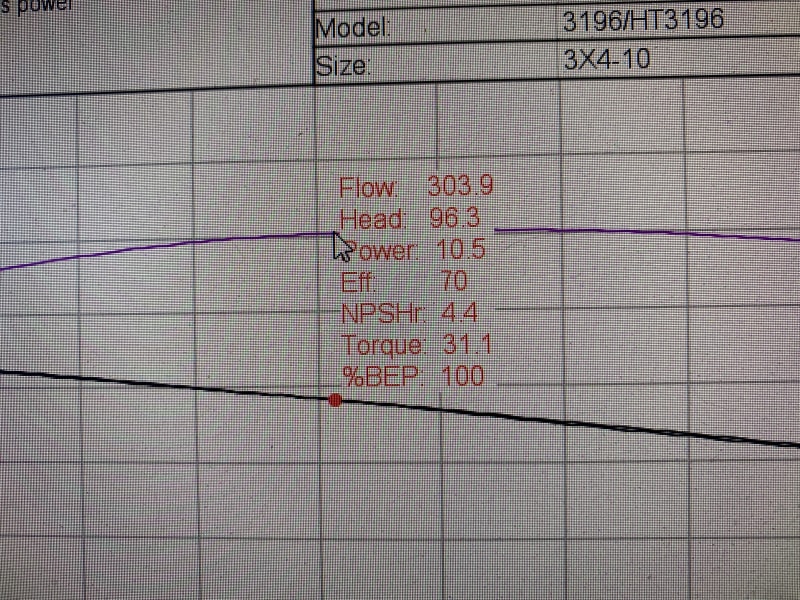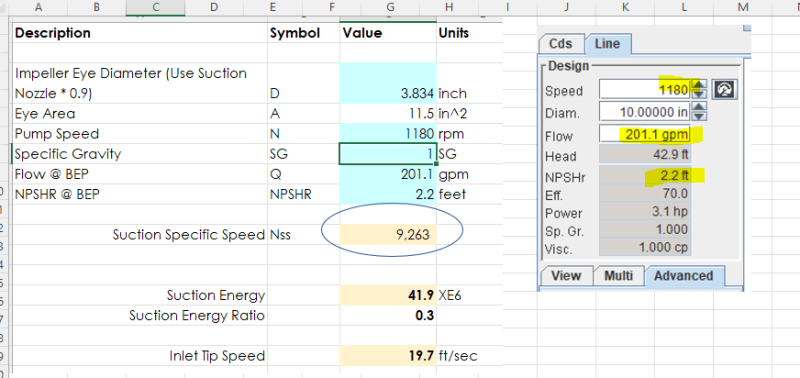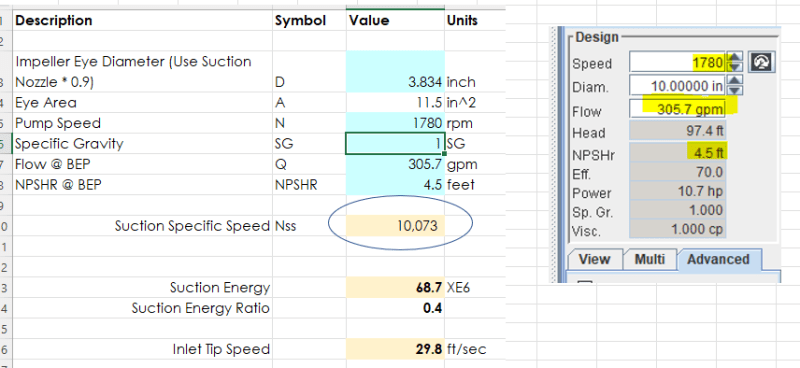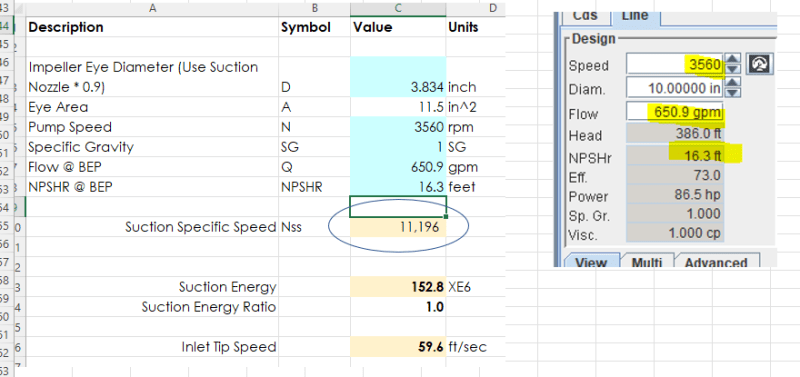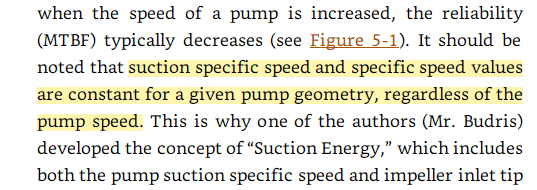Hi,
I had been under the assumption that the calculation of Suction Specific Speed used the actual operating speed, not the maximum design speed. Last week, I noticed that the Goulds E-Prism program shows the same Nss regardless of speed. i.e... they show the same Nss for 3600 rpm, 1800 rpm and 1200 rpm. I can come up with the same Nss as long as I use 3600 rpm.
I contacted the local Goulds/ITT rep and mentioned it to him. He forwarded an article from Alan Budris, that indicated Nss was an index that doesn't vary with speed. Below is s quote from a book he wrote with Heinz Bloch, saying the same thing.
"It should be noted that suction specific speed and specific speed values are constant for a given pump geometry, regardless of the pump speed. This is why one of the authors (Mr. Budris)developed the concept of “Suction Energy,” which includes both the pump suction specific speed and impeller inlet tip speed (speed × diameter)"
Bloch, Heinz; Budris, Allan. PUMP USER'S HANDBOOK: LIFE EXTENSION, 4th Edition (Kindle Locations 3086-3087). The Fairmont Press, Inc.
However, API-610 uses the words "at a given rotative speed" It doesn't say to use the maximum design speed.

This make more sense to me. The impeller doesn't know what it's maximum design speed is. So Nss calculated at the actual operating speed (using Q and NPSH at the BEP for that speed) seems to make sense.
At least I understand why Alan Budris added "N" in the suction energy calculation. Since he was under the belief that Nss (or S) is based on the maximum design speed of the pump. It does not make sense to say Nss is "constant for a fixed geometry".....since there are no terms in Nss that directly indicate geometry.
What do you guys think? Should NSS vary with the "given rotative speed". It is certainly makes it more useful. It can be used to estimate the improvement from speed reduction, for example.
Thanks in advance for your thoughts and help
I had been under the assumption that the calculation of Suction Specific Speed used the actual operating speed, not the maximum design speed. Last week, I noticed that the Goulds E-Prism program shows the same Nss regardless of speed. i.e... they show the same Nss for 3600 rpm, 1800 rpm and 1200 rpm. I can come up with the same Nss as long as I use 3600 rpm.
I contacted the local Goulds/ITT rep and mentioned it to him. He forwarded an article from Alan Budris, that indicated Nss was an index that doesn't vary with speed. Below is s quote from a book he wrote with Heinz Bloch, saying the same thing.
"It should be noted that suction specific speed and specific speed values are constant for a given pump geometry, regardless of the pump speed. This is why one of the authors (Mr. Budris)developed the concept of “Suction Energy,” which includes both the pump suction specific speed and impeller inlet tip speed (speed × diameter)"
Bloch, Heinz; Budris, Allan. PUMP USER'S HANDBOOK: LIFE EXTENSION, 4th Edition (Kindle Locations 3086-3087). The Fairmont Press, Inc.
However, API-610 uses the words "at a given rotative speed" It doesn't say to use the maximum design speed.

This make more sense to me. The impeller doesn't know what it's maximum design speed is. So Nss calculated at the actual operating speed (using Q and NPSH at the BEP for that speed) seems to make sense.
At least I understand why Alan Budris added "N" in the suction energy calculation. Since he was under the belief that Nss (or S) is based on the maximum design speed of the pump. It does not make sense to say Nss is "constant for a fixed geometry".....since there are no terms in Nss that directly indicate geometry.
What do you guys think? Should NSS vary with the "given rotative speed". It is certainly makes it more useful. It can be used to estimate the improvement from speed reduction, for example.
Thanks in advance for your thoughts and help

